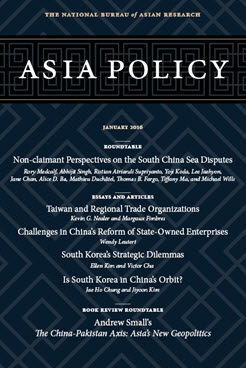Is South Korea in China's Orbit?
Assessing Seoul's Perceptions and Policies
This article examines South Korea’s perceptions of and policies toward China, particularly since President Park Geun-hye’s inauguration in 2013, and assesses the thesis that Seoul is in the Chinese orbit.
EXECUTIVE SUMMARY
MAIN ARGUMENT
Although the view that South Korea is tilting increasingly toward China at the expense of its relations with the U.S. has been gaining an audience in some corners of the U.S. and Japan in recent years, this thesis is largely ungrounded. It is challenged both by an assessment of Xi Jinping’s state visit to South Korea in July 2014 and by an analysis of South Korean perceptions toward China in seven issue domains: China’s rise, historical disputes, the sharing of norms and values, territorial disputes, North Korea, reunification, and the ROK-U.S. alliance. Nonetheless, nascent concerns about North Korea’s renegade behavior and China’s rise are in the backdrop of Seoul’s recent approach to China. Down the road, the number of issues over which Seoul must agonize will only increase, thereby leading the U.S. to worry about China’s influence over South Korea more often than ever before.
POLICY IMPLICATIONS
- South Korea’s policies and perceptions toward China, though varying by issue, overall are embedded in recognition of the high uncertainty surrounding China’s rise and how it will relate to the fate of North Korea.
- In order to mitigate or eradicate faulty assumptions and perceptions, both Track 1 and Track 1.5 dialogues need to be held more frequently between South Korea, Japan, and China, as well as between South Korea, the U.S., and China.
- The accelerating pace of China’s ascent is likely to make important issues of contention arise more frequently, pushing Seoul to choose between Washington and Beijing.
About Asia Policy
Asia Policy is a peer-reviewed scholarly journal presenting policy-relevant academic research on the Asia-Pacific that draws clear and concise conclusions useful to today’s policymakers. Asia Policy is published quarterly in January, April, July, and October and accepts submissions on a rolling basis. Learn more


